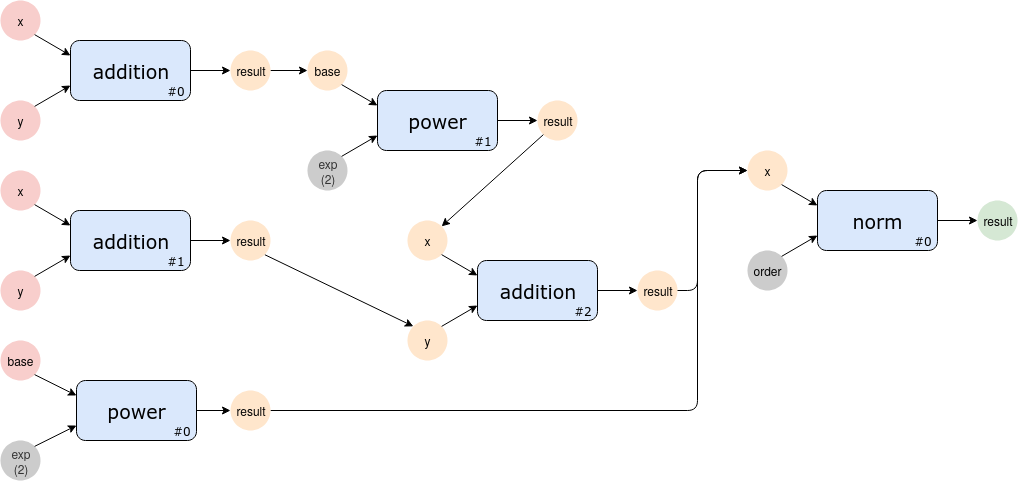Multiple Identical Nodes¶
In cases where a particular node needs to be executed multiple times in the
same pipeline, the Pipe model’s
source_run_index and
destination_run_index
attributes should be used.
As an example for a pipeline running multiple identical nodes, we will create the following pipeline:

We will assume the existence of the three nodes:
- addition: Adds two number to return “result”.
- power: Raises base in the power of exp. In this case we have a “square” node, where exp is preconfigured as 2.
- norm: Calculated the norm of the provided vector (x) using NumPy’s
linalg.norm()method.
Each node has a designated run index in it’s bottom right corner, distinguishing it from other executions of this node.
To create the pipeline, we will first create a pipeline specification dictionary:
ADDITION_NODE = {
"analysis_version": "addition",
"configuration": {},
}
SQUARE_NODE = {
"analysis_version": "power",
"configuration": {"exp": 2},
}
NORM_NODE = {
"analysis_version": "norm",
"configuration": {},
}
PIPELINE = {
"title": "Multiple Identical Nodes",
"description": "Simple pipeline with identical nodes.",
"pipes": [
# Addition #0 [result] --> Power #1 [base]
{
"source": ADDITION_NODE,
"source_run_index": 0,
"source_port": "result",
"destination": SQUARE_NODE,
"destination_run_index": 1,
"destination_port": "base",
},
# Power #1 [result] --> Addition #2 [x]
{
"source": SQUARE_NODE,
"source_run_index": 1,
"source_port": "result",
"destination": ADDITION_NODE,
"destination_run_index": 2,
"destination_port": "x",
},
# Addition #1 [result] --> Addition #2 [y]
{
"source": ADDITION_NODE,
"source_run_index": 1,
"source_port": "result",
"destination": ADDITION_NODE,
"destination_run_index": 2,
"destination_port": "y",
},
# Power #0 [result] --> Norm #0 [x[0]]
{
"source": SQUARE_NODE,
"source_run_index": 0,
"source_port": "result",
"destination": NORM_NODE,
"destination_run_index": 0,
"destination_port": "x",
"index": 0,
},
# Addition #2 [result] --> Norm #0 [x[1]]
{
"source": ADDITION_NODE,
"source_run_index": 2,
"source_port": "result",
"destination": NORM_NODE,
"destination_run_index": 0,
"destination_port": "x",
"index": 1,
},
],
}
Note that we also used the Pipe
model’s index attribute to
pass two outputs as a single list (vector) to the norm nodes x parameter.
To run the pipeline, we need to specify both x and y for the first two addition executions, as well as the base to the first power execution.
>>> from django_analyses.models import AnalysisVersion
>>> from django_analyses.models import Node
>>> from django_analyses.models import Pipeline
>>> from django_analyses.pipeline_runner import PipelineRunner
# Import the pipeline specification dictionary created above
>>> from multiple_identical_nodes import PIPELINE
# Create the pipeline
>>> pipeline = Pipeline.objects.from_dict(PIPELINE)
# Fetch the nodes for the inputs dictionary
>>> addition = AnalysisVersion.objects.get(analysis__title="addition")
>>> power = AnalysisVersion.objects.get(analysis__title="power")
>>> addition_inputs = [{"x": 1, "y": 1}, {"x": 1, "y": 1}]
>>> power_inputs = [{"base": 1}]
>>> inputs = {addition: addition_inputs, power: power_inputs}
>>> runner = PipelineRunner(pipeline=pipeline)
>>> results = runner.run(inputs=inputs)
power v1.0 (#0)
Inputs:
{'base': 1}
...
Outputs:
{'result': 1.0}
────────────────────
addition v1.0 (#0)
Inputs:
{'x': 1, 'y': 1}
...
Outputs:
{'result': 2.0}
────────────────────
────────────────────
power v1.0 (#1)
Inputs:
{'base': 2.0}
...
Outputs:
{'result': 4.0}
────────────────────
────────────────────
addition v1.0 (#1)
Inputs:
{'x': 1, 'y': 1}
...
Outputs:
{'result': 2.0}
────────────────────
────────────────────
addition v1.0 (#2)
Inputs:
{'y': 2.0, 'x': 4.0}
...
Outputs:
{'result': 6.0}
────────────────────
────────────────────
norm vNumPy:1.18 (#0)
Inputs:
{'x': [1.0, 6.0]}
...
Outputs:
{'norm': 6.08276253029822}
────────────────────
done!
>>> norm = AnalysisVersion.objects.get(analysis__title="norm")
>>> results[norm][0].get_output("norm")
6.082762530298219